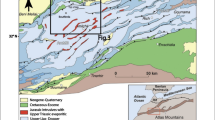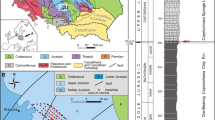Abstract
Separating anomalies plays a critical role on mineral exploration. In this paper, IP anomalies have been determined by concentration-area (C-A) and singularity methods. Then a comparison has been made between the methods. The singularity map (as well as fractal method) is usually applied in the geochemical exploration process; however, it has not been widely used in the geoelectrical methods so far. In this research, it has been successfully applied to utilize this method to process IP data (recognize anomaly induced polarization data in Hamyj copper deposit). Hamyj deposit is located about 80 km west of Birjand city, South Khorasan province, Iran. In this area, resistivity and induced polarization data have been surveyed by dipole-dipole array. Finally, according to the mentioned method, 67 % of the anomalies (singularity index) are confirmed by the concentration-area method which showed significant adaption with each other. Also, a suitable area is determined by a singularity map for drilling.








Similar content being viewed by others
References
Bai J, Porwal A, Hart C, Ford A, Yu L (2010) Mapping geochemical singularity using multifractal analysis: Application to anomaly definition on stream sediments data from Funin Sheet, Yunnan China. J Geochem Explor 104(1):1–11
Barton CC, La Pointe PR (1995a) Fractals in petroleum geology and earth processes. Plenum Press, New York, pp 59–72
Barton CC, La Pointe PR (1995b) Fractals in the earth sciences. Plenum Press, New York, pp 77–141
Cheng Q (2006) Singularity-generalized self-similarity-fractal spectrum (3S) model. Earth Sci China Univ Geosci 31:337–348 (in Chinese with English abstract)
Cheng Q (2007) Mapping singularities with stream sediment geochemical data for prediction of undiscovered mineral deposits in Gejiu, Yunnan Province China. Ore Geol Rev 32:314–324
Cheng Q (2008) Non-linear theory and power-law models for information integration and mineral resources quantitative assessments. Math Geol 40:503–532
Dhu T, Dentith MC, Hillis RR (1999) The use of fractal dimension estimators for enhancing airborne magnetic data. Explor Geophys 30(1/2):33–37
Govett GJS, Goodfellow WD, Chapman A, Chork CY (1975) Exploration geochemistry distribution of elements and recognition of anomalie. Math Geol 7(5–6):415–446
Grunsky EC, Agterberg FP (1988) Spatial and multivariate analysis of geochemical data from metavolcanic rocks in the Ben Nevis area. Ontario Math Geol 20(7):825–861
Khalid P, Ghazi S (2013) Discrimination of fizz water and gas reservoir 1 by AVO analysis: a modified approach. Acta Geod et Geophys 48(3):347–361
Mandelbrot BB (1967) How long is the coast of Britain? Statistical self-similarity and fractional dimension. Science 156(3775):636–638
Oldenburg DW, Li Y (1994) Inversion of induced polarization data. Geophysics 59(9):1327–1341
Scholz C, Mandelbrot BB (1992) Special issue on fractals in geology and geophysics. Pure Appl Geophys 131:96–171
Shahi Ferdows M, Bicharanlo Hasan M, Poormirzaee R (2014) Integration of Geoelectrical information layers by fuzzy method to choose the best point for drilling: a case study Hamyj, Birjand. J Earth Space Phys 40(1):95–105 (in Persian)
Sinclair AJ (1974) Selection of thresholds in geochemical data using probability graphs. Geochem Explor 3(2):129–149
Sinclair AJ (1976) Application of probability graphs in mineral exploration. Geochem Explor 4:95
Sinclair AJ (1991) A fundamental approach to threshold estimation in exploration geochemistry: probability plots revisited. Geochem Explor 41(1):1–22
Stanley CR, Sinclair AJ (1989) Comparison of probability plots and gap statistics in the selection of threshold for exploration geochemistry data. Geochem Explor 32(1):355–357
Telford MW, Geldart LP, Sheriff RE (1990) Applied geophysics. Cambridge University, New York, p 726
Xiao F, Chen J, Zhang Z, Wang C, Wu G, Agterberg FP (2012) Singularity mapping and spatially weighted principal component analysis to identify geochemical anomalies associated with Ag and Pb-Zn polymetallic mineralization in Northwest Zhejiang, China. J Geochem Explor 122:90–100
Zuo R, Cheng Q, Agterberg FP, Xia Q (2009) Application of singularity mapping technique to identify local anomalies using stream sediment geochemical data, a case study from Gangdese, Tibet, western China. Geochem Explor 101(3):225–235
Author information
Authors and Affiliations
Corresponding author
Rights and permissions
About this article
Cite this article
Ferdows, M.S., Ramazi, H.R. Application of the singularity mapping technique to identify local anomalies by polarization data (a case study: Hamyj Copper Deposit, Iran). Acta Geod Geophys 50, 365–374 (2015). https://doi.org/10.1007/s40328-015-0112-x
Received:
Accepted:
Published:
Issue Date:
DOI: https://doi.org/10.1007/s40328-015-0112-x




